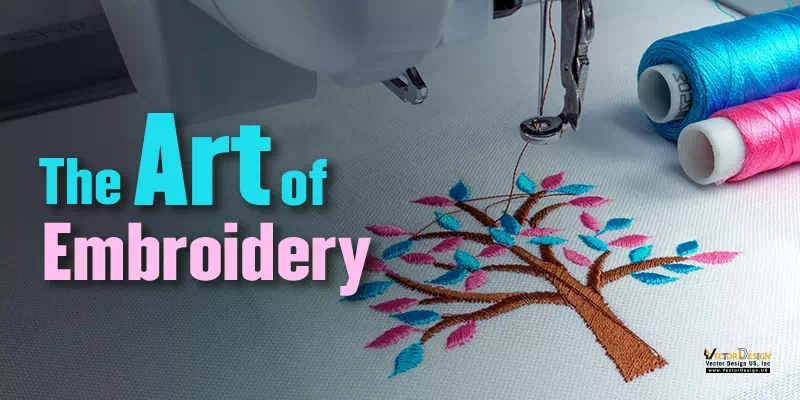Embroidery is a venerable art form that involves adorning fabrics with intricate designs through the skilled use of needles and thread. This traditional embroidery technique has adapted to modern times by incorporating digitization as a key step. Digitizing helps embroidery machines copy designs accurately. It turns pictures into digital instructions. Let’s learn about this cool process!
Get ready to discover the exciting blend of old traditions and new technology in embroidery! We’re exploring how ancient skills and modern digital tools come together to create something amazing. Come along as we explore the connection between the past and the super precise future!” In the world of embroidery digitizing, we uncover a powerful harmony between timeless craftsmanship and cutting-edge technology.
Definition of digitizing in embroidery
Digitizing in embroidery is like giving special instructions to a computer so it can make beautiful designs using threads on fabric.
It is the process of transforming an artwork or design into a digital format that can be understood and duplicated by embroidery machines. Imagine turning colors, shapes, and textures into directions for embroidery machines. This ensures the stitches on the fabric are perfect and the artwork looks amazing!
Preparing Artwork for Digitizing
As the gateway to transforming creative ideas sets the stage for a seamless journey. This crucial process involves refining and selecting designs that pave the way for their intricate conversion into digitized embroidery.
Selection of suitable artwork for digitizing
Selecting the right artwork for digitizing is crucial. Choose designs with clear lines, distinct shapes, and defined elements. Pay attention to complexity, size, and detailing, and use high-resolution images for accuracy. Thoughtful selection ensures compatibility with digitizing software and sets the stage for successful embroidery outcomes.
Importance of clean and clear designs for optimal digitizing
Clean and clear designs are pivotal for achieving optimal digitizing results. When the original artwork is free from clutter, stray marks, and ambiguities, the digitizing process becomes smoother. Clear lines and well-defined elements ensure that the digitized embroidery accurately mirrors the intended design. Such designs reduce the likelihood of errors, misinterpretations, and distortions during digitization, ultimately leading to higher-quality embroidered outcomes.
Understanding Stitch Types and Techniques
Embroidery’s magic resides in stitches’ artistry. ‘Understanding Stitch Types and Techniques’ unveils the diverse stitches at hand, illustrating their roles in crafting textured designs.
Explanation of different stitch types
Satin, fill, and running—serve distinct roles in embroidery. Satin stitches offer smooth borders, fills add texture, and running stitches outline details. Combining these types strategically enhances designs with depth and dimension.
Techniques for achieving texture, dimension, and shading through stitch variations
Embroidery uses stitch manipulation for texture, dimension, and shading. Varied stitch lengths and densities create texture. While layering stitches adds depth. Gradual changes in thread color and stitch direction generate shading and highlights. Mastering these techniques enhances the visual impact of embroidered creations.
Digitizing Process Step by Step
This guide simplifies the art of embroidery, showing how ideas turn into colorful stitched creations.
Importing and digitizing artwork in digitizing software
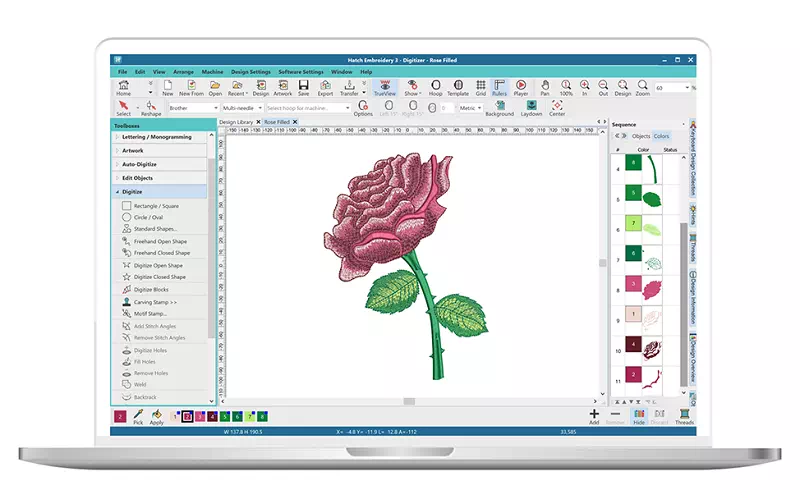
To start, we use special software to bring pictures to the computer. This software helps turn the pictures into instructions that embroidery machines can understand. We use tools to draw shapes, pick stitch types, and choose colors. This makes sure the design looks right when the machine sews it onto fabric. This step helps connect creative ideas with accurate embroidery.
Setting up stitch parameters
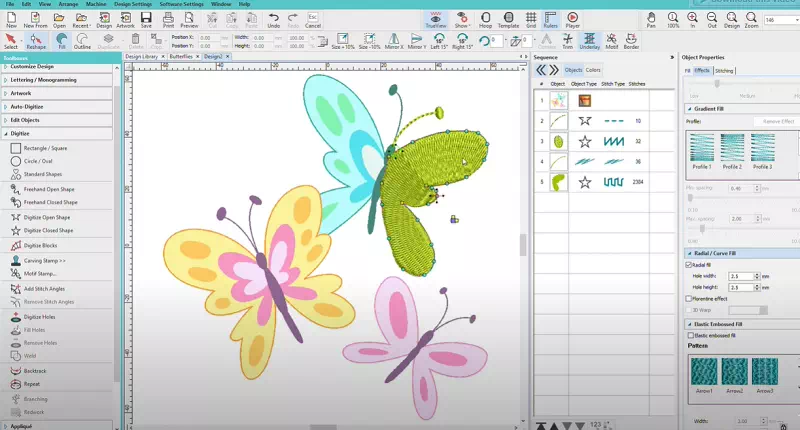
We need to set up the tiny details of the stitches, like how long they are, how close they are, and which direction they go. This is important because it makes sure the embroidery looks perfect on the fabric and matches the design. We can even adjust how the stitches are placed underneath to make the design even better. It’s like customizing the stitches for each design and fabric.
Assigning stitch types to different elements of the design
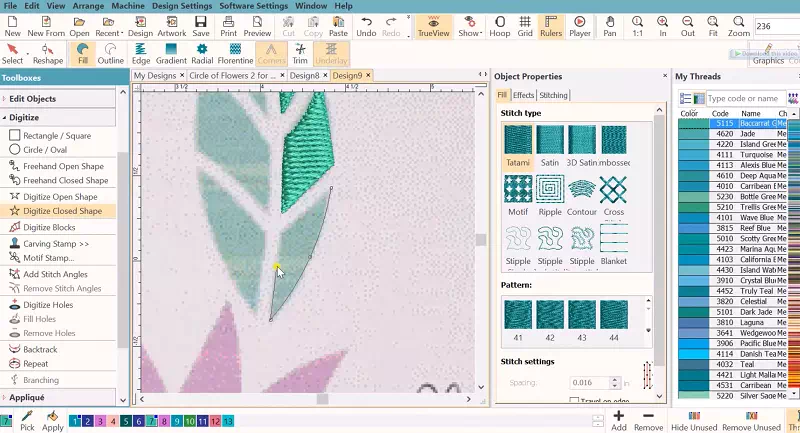
In digitizing, assigning stitch types involves strategically choosing stitches—satin, fill, or running—for different parts of the design. Satin stitches work for smooth edges, fill stitches provide texture, and running stitches outline details. By skillfully selecting stitch types, you bring out the design’s visual and tactile intricacies, enhancing its overall impact when stitched onto fabric.
Creating color stops and assigning thread colors
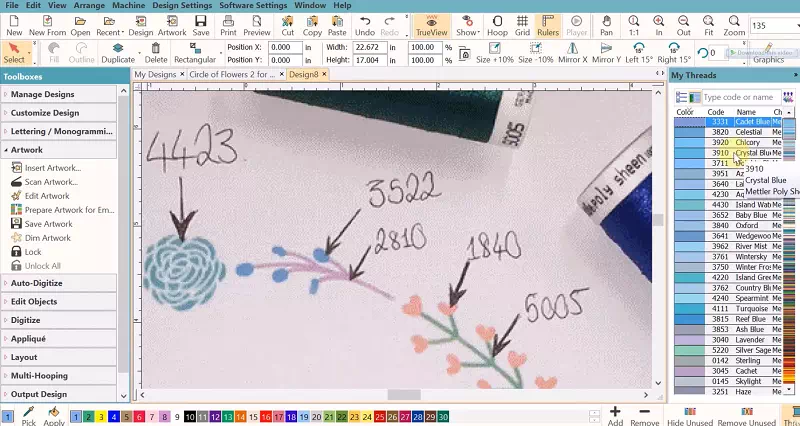
Creating color stops involves dividing the design into segments for thread changes, allowing different thread colors to be assigned to each segment. By strategically assigning thread colors to these segments, you control the embroidery machine’s color changes during stitching. This process ensures that the design’s colors are accurately replicated, producing a vibrant and true-to-design embroidered result.
Previewing and adjusting the digitized design for accuracy
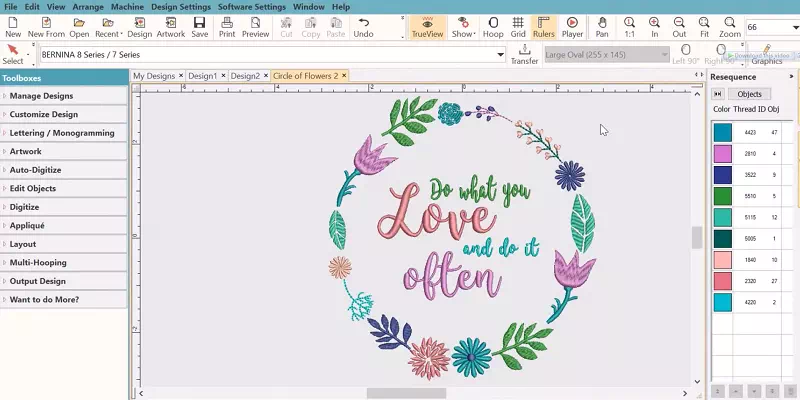
After digitization, previewing the design of the software is crucial. This step allows you to assess accuracy and make necessary adjustments. You can fine-tune stitch placements, modify stitch parameters, and refine color choices. Previewing ensures that the digitized design aligns perfectly with your vision before it’s stitched, guaranteeing a flawless and precisely executed final product.
Software and tools used in digitizing the process
Exploring Software and Tools in Digitizing, let’s uncover the tools that transform designs into embroidery, making creativity come alive with technology.
Embroidery Digitizing Software
Embroidery digitizing software is a specialized tool that transforms visual designs into digitized instructions for embroidery machines. This software allows users to import artwork, set stitch parameters, assign stitch types, and designate thread colors. With its user-friendly interface and advanced features, embroidery digitizing software is a key tool in translating creative concepts into accurate and detailed embroidered designs.
Vector Graphics Software
Vector graphics software is a tool used to create and manipulate vector-based images. It allows users to create scalable and editable designs, making it an essential tool for creating artwork that needs to be resized without losing quality.
Digitizing Tablets
Digitizing tablets are input devices used to directly create digital designs by drawing on a surface with a stylus or pen. They are particularly useful for precise and detailed work. It makes them a favored tool for graphic designers, illustrators, and those involved in embroidery digitizing.
Embroidery Machine
An embroidery machine automates stitching intricate designs onto fabric by interpreting digital embroidery files, using needles and threads to recreate the design accurately and efficiently.
Thread Color Conversion Tools
Thread color conversion tools are software or resources that help convert thread colors between different embroidery thread brands. These tools help make sure that the colors stay the same when we use different threads. This way, the colors look the way we want them to in all the embroidery projects we do. It’s like keeping things consistent and making sure the colors look just right every time.
Online Resources
Online resources are like websites, forums, and tutorials that have helpful stuff about digitizing. These digital places give us tips, ideas, and tools for digitizing. They show us how to do things, help us when there’s a problem, and let us talk to others who like digitizing too. These resources make it easier to learn and be creative when we’re digitizing.
Advantages of Embroidery Digitizing
Discover the perks of the Advantages of Embroidery Digitizing. This journey explores how technology enhances embroidery, making designs more accurate and colorful.
- Precision: Advantages of embroidery digitizing include achieving us make very precise and detailed designs. Embroidery digitizing is great because it helps us make very precise and detailed designs. When we digitize, we can create tiny details that might be hard to do by hand. This makes sure our embroidered designs look just right and really well done.
- Consistency: Embroidery digitizing ensures design consistency, delivering a uniform and professional appearance across items. This consistency ensures that the final product reflects the intended design and branding across multiple items and applications.
- Efficient Storage: Embroidery digitizing enables efficient design storage, reducing physical space and ensuring easy retrieval for future use
- Complex Color Blending: Embroidery digitizing allows intricate color blending, achieving gradients and shading that can be challenging through manual methods. This adds depth and visual complexity to designs.
- Quick Turnaround: Embroidery digitizing offers swift production turnaround, as digitized designs can be quickly stitched onto fabric, enhancing overall efficiency.
- Global Collaboration: Embroidery digitizing helps people from all around the world work together. Designers and clients can team up even if they’re far away. They can send designs using computers, and they can talk easily no matter where they are. This makes working together super smooth, even if they’re in different parts of the world.
Challenges and Considerations in Digitizing
Let’s uncover the hurdles and important factors. And turning designs into embroidery, making the process smoother.
Challenges
- Complex Designs: Converting intricate and highly detailed artwork into digitized formats can be challenging due to the need for precise stitch placement and maintaining design integrity.
- Color Matching: Achieving accurate color representation on embroidery machines can be difficult, as thread colors may appear differently when stitched compared to digital designs.
- Small Text and Details: Digitizing small text and intricate details requires careful consideration of stitch size and spacing to ensure legibility and visual clarity.
- Stitch Density: Balancing stitch density is essential to prevent overcrowding or gaps in the design, ensuring proper coverage and a balanced overall appearance.
Considerations
- Design Complexity: Assessing the intricacy of the design is crucial, as complex designs may require more stitches and attention to detail during digitization to ensure accurate replication.
- Thread Selection: Choosing appropriate thread types and colors is vital to achieve desired visual effects and ensure compatibility with the embroidery machine’s capabilities
- Fabric Type: The type of fabric impacts digitization, as different fabrics require adjustments in stitch density and techniques to prevent distortion or damage during embroidery.
- Size Considerations: Adapting the design’s size to fit the intended fabric or item is important, as overly small or large designs can result in loss of detail or difficulty in stitching.
Conclusion
In summary, delving into the intricacies of the digitizing process reveals its pivotal role in transforming creative visions into precise and vibrant embroidered designs. From selecting suitable artwork and assigning stitch types to navigating software tools and considering fabric types, embroidery digitizing is a fusion of craftsmanship and technology.
In the end, as we finish up, the world of embroidery digitizing encourages us to keep exploring, keep learning, and be excited about all the new things we can do in this changing and exciting area. So, let’s keep discovering, keep growing, and keep enjoying all the cool things embroidery digitizing can bring!
Related

